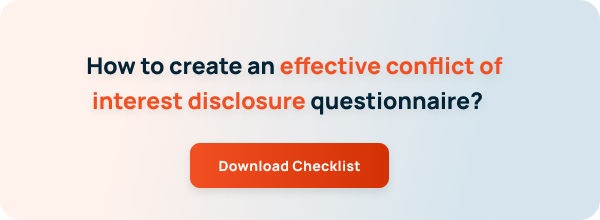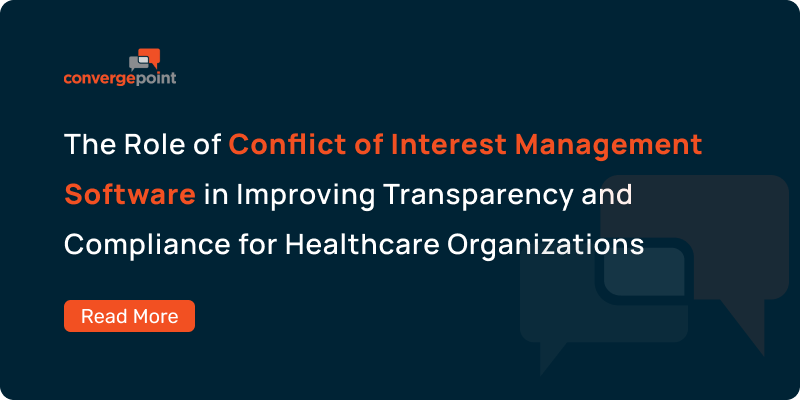
Government Contracts and Ethics Compliance: Managing Conflicts in Utilities
Public-private partnerships in the utility sector are under sharper scrutiny than ever. Whether managing a regional water system, delivering power grid upgrades, or executing renewable energy infrastructure, utilities regularly engage with government entities through long-term, high-value contracts. With this responsibility comes a growing expectation for transparency, accountability, and ethics compliance.
The financial, legal, and reputational risks from unaddressed conflicts of interest (COIs) are substantial. A single undisclosed relationship—between a board member and a contractor, for example—can derail projects, attract public audit inquiries, or disqualify the utility from future procurement opportunities. For senior compliance and legal officers, ethics is no longer just about policy—it's about provable, auditable governance.
As governments prioritize integrity in procurement, and ESG pressures heighten scrutiny over utility operations, utilities must now prove that COI oversight is embedded in their daily processes—not just documented in policy binders. In this article, we explore the realities of COI risk in utility contracting, the regulatory frameworks in place, and how Microsoft 365-SharePoint based conflict of interest software empowers utilities to stay compliant, auditable, and procurement-eligible.
Understanding Conflicts of Interest in Utilities
What Constitutes a COI in the Utilities Sector?
Conflicts of interest arise when personal or professional affiliations interfere—or appear to interfere—with objective decision-making in procurement, staffing, or partnerships. In utilities, these risks are especially acute due to the long-term nature of government contracts and close-knit vendor ecosystems.
Common COI examples in this space include:
-
Procurement relationships with suppliers tied to staff, contractors, or board members.
-
Financial interests held by decision-makers in bidding entities or subcontractors.
-
Undisclosed family connections between evaluators and vendor representatives.
-
Hiring of former regulators or government officials into roles connected to their prior oversight responsibilities.
Even when not illegal, the perception of bias or self-dealing can damage a utility’s standing with regulators, procurement boards, and the public.
“In many utilities, vendor relationships span decades. Without continuous disclosure cycles, even well-intentioned stakeholders may overlook evolving conflicts.”
Why Utilities Are Uniquely Exposed
Utilities operate in environments where:
-
Long-term service models create embedded relationships that can obscure financial interests.
-
Regional monopolies mean fewer vendors and increased scrutiny over procurement fairness.
-
Public funding mechanisms require compliance with strict disclosure and review obligations.
The utility sector operates in a trust-based environment, where conflict transparency is both a regulatory expectation and a license to operate.
Legal and Compliance Frameworks Across Jurisdictions
United States
-
FAR Subpart 3.1 & 9.5: Addresses personal conflicts and organizational conflicts in federal contracting. Disclosure is mandatory for both prime contractors and subcontractors.
-
Public Utility Commission (PUC) Ethics Rules: State-level rules govern utility board ethics, procurement disclosures, and recusal requirements.
Canada
-
Federal Accountability Act and Provincial Procurement Acts: Require conflict disclosure in federally funded projects and provincial utility contracts.
United Kingdom
-
Public Contracts Regulations 2015: Mandate exclusion of bidders with undisclosed conflicts and require audit trails for compliance.
South Africa
-
Public Finance Management Act (PFMA): Prohibits conflicts in state-owned utility procurement and mandates ethics officer involvement.
Australia & New Zealand
-
Commonwealth Procurement Rules (CPRs) and Government Procurement Rules: Emphasize managing perceived conflicts and require formal disclosures and ethics training.
Common Compliance Mechanisms:
-
Whistleblower laws: Support anonymous reporting of COI violations.
-
Audit panels: Review COI records for bid protests and regulatory approvals.
-
Public registries: In some regions, utilities must publish conflict disclosures for board and executive positions.
Building an Effective Internal COI Program
What a Structured COI Program Includes
An ethics compliance program in utilities should be:
-
Recurring and role-specific: COIs are collected not just at onboarding, but during project milestones and contract renewals.
-
Workflow-driven: Reviews are routed to managers, legal, or committees depending on role and risk.
-
Actionable: Outcomes like recusal, mitigation, or rejection are documented with time stamps.
-
Auditable: Every submission and decision is stored for future review by regulators or procurement boards.
Where Gaps Persist
Even with formal policies, many utilities fall short in execution. Common gaps include:
-
Disconnected tools (email forms, PDFs) with no tracking or escalation.
-
Inconsistent reviewer responsibilities or role-based access.
-
Lack of follow-up on disclosed conflicts.
-
Static COI snapshots with no re-evaluation for long-term vendor relationships.
A modern COI program is not just a checklist—it's a system that embeds transparency into operations, ensures accountability, and reduces public-sector risk.
Technology as a Compliance Enabler
ConvergePoint Conflict of Interest Disclosure Software
ConvergePoint COI software, built within Microsoft 365 SharePoint, allows utility companies to embed COI management directly into their governance workflow. The platform is purpose-built for regulated sectors, offering more than just form submissions.
Key components of the platform include:
-
Dynamic, Role-Specific Disclosure Forms: Configured based on the user's department, location, and conflict type, with logic-driven questions using ConvergePoint’s centralized Questions Library.
-
Automated Escalation Workflows: Depending on the conflict disclosed, forms escalate automatically from Reviewer to Manager to Committee. Each role has defined review rights and actions such as 'Ask Question,' 'Pending Verification,' or 'Conflict Managed.'
-
Disclosures Page: Displays the full lifecycle of a submission—who submitted it, the current review stage, status, assigned reviewer, and timeline indicators (e.g., blinking dots for active steps).
-
License Manager: Admins assign access by user or Active Directory group, defining roles like Reviewer, Manager, Committee Member, or Viewer. Licenses can be reassigned dynamically based on project need or organizational change.
-
Task Reassignment and Visibility: COI Administrators can reassign open tasks, track overdue reviews, and generate real-time status reports segmented by department or disclosure type.
-
Time-Stamped Audit Logs: Every decision, comment, and form revision is tracked for regulatory and internal audit readiness.
-
Microsoft 365 Native Data Control: All disclosure data remains inside your organization’s Microsoft tenant—no third-party cloud storage. Permissions and security are enforced through Entra ID and SharePoint site groups.
Jurisdiction-Aware Configuration
For utilities operating in multiple regions, ConvergePoint supports:
-
Separate workflows for each regulatory body.
-
Localized form fields to meet jurisdictional disclosure requirements.
-
Filtered reports by region, agency, or entity for external audits.
By bringing disclosure tracking into a unified system, utilities reduce administrative load, demonstrate regulatory alignment, and respond to audit inquiries with confidence.
Strategic Use Cases in Utility Ethics Management
1. Pre-Bid Conflict Validation for Government Projects
When preparing to submit proposals for government-funded infrastructure, utility providers are often required to certify the absence of undisclosed conflicts among key personnel. ConvergePoint allows compliance administrators to initiate pre-bid disclosure workflows targeted to specific projects or roles.
-
Role-based form assignment enables administrators to assign disclosures to procurement, engineering, or leadership staff depending on project involvement.
-
Workflow escalation is triggered when flagged responses (e.g., vendor relationships, familial ties) require review by legal or ethics officers.
-
Audit trail exports provide procurement teams with a complete documentation record—including reviewer comments and final determinations—that can be submitted as part of RFP compliance packets.
2. Ethics Oversight for Government-Supported Renewable Projects
Utility companies involved in renewable energy initiatives subsidized by federal or state entities face increased transparency requirements. ConvergePoint supports the compliance process by enabling structured oversight at the board and executive level.
-
Disclosure requests can be assigned to groups such as Board Members or Executives using Active Directory group assignments via the License Manager.
-
System notifications prompt disclosures based on role type and timeline, with administrator-managed recurring cycles for ongoing transparency.
-
Flagged interests—such as equity in renewable energy companies—can be escalated to COI Committee members for in-depth review and mitigation documentation.
3. Conflict Assessment During Hiring of Public-Sector Veterans
Hiring former regulators or public-sector employees into compliance-sensitive roles requires COI due diligence. ConvergePoint equips HR and compliance staff with the tools to vet candidates through documented workflows.
-
Tailored pre-hire disclosure forms collect information on prior affiliations, agency interactions, and past rulings.
-
Disclosure workflows escalate automatically when responses indicate potential prior oversight of the utility, triggering reviews by COI Managers or Committees.
-
Cooling-off period policies can be implemented administratively and tied to documented resolutions logged within the system for audit reference.
4. Coordinated Compliance for Multi-Agency Infrastructure Programs
Projects involving joint funding or oversight from multiple government agencies—municipal, state, and federal—require tailored compliance handling. ConvergePoint enables utilities to coordinate and isolate workflows accordingly.
-
Multiple COI workflows can be configured and assigned based on project type, agency funding, or jurisdiction.
-
Form-level metadata such as “Agency Name” or “Funding Source” allows filtering and reporting by regulatory entity.
-
Disclosures Page dashboards provide real-time tracking of submissions, pending reviews, and final outcomes segmented by department, project, or agency.
Why Utilities Trust ConvergePoint
Utilities choose ConvergePoint because it does more than check a box. It transforms COI compliance from a paper-heavy risk to a transparent, auditable system of record that:
-
Lives within Microsoft 365—no third-party tools required.
- Aligns to agency-specific rules and formats.
- Tracks accountability by role and region.
-
Supports both self-initiated and assigned disclosures.
-
Provides clear documentation to satisfy audit inquiries and procurement board reviews.
Aligning Governance with the Realities of Public Utility Contracts
Ethics compliance in the utilities sector is under rising pressure—from regulators, funding agencies, and the communities these companies serve. Government-awarded contracts demand more than just a signed policy or annual certification. They require active oversight, traceable accountability, and operational systems that can stand up to public and regulatory scrutiny.
Conflicts of interest pose a real risk to contract integrity, rate approvals, and institutional reputation. Utilities that rely on manual disclosures or disconnected review processes open themselves to delays, audits, and potential procurement disqualification.
What’s needed is a structure that aligns with how utilities actually work: regionally regulated, procurement-driven, and often operating across multiple jurisdictions and funding streams. That structure is only achievable when conflict disclosures, review workflows, and audit trails are unified in a platform that mirrors the utility’s operational and regulatory complexity.
ConvergePoint’s Conflict of Interest Disclosure Software—deployed entirely within Microsoft 365 SharePoint—delivers that foundation. It allows utilities to manage their ethics posture with the same discipline they apply to engineering, finance, and infrastructure planning.
Discover how utility compliance and procurement teams are using Microsoft 365-based tools to track risk, align with multi-agency requirements, and protect their public accountability. Request a tailored demo today!


%20Management%20Software%20for%20Renewable%20Energy.png?t=1693911553902)

